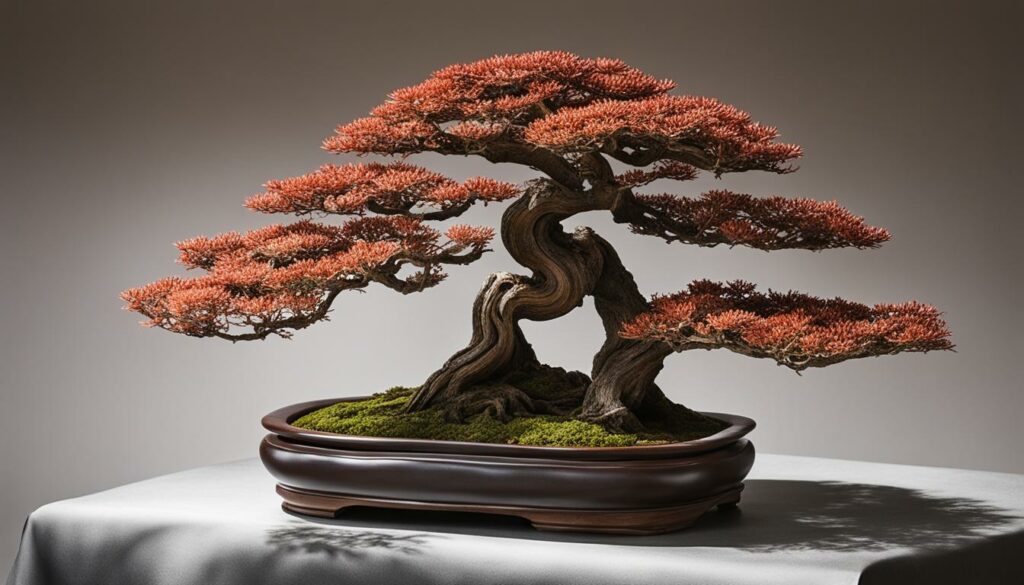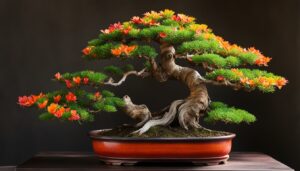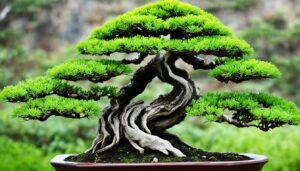Creating a bonsai tree is an art form that requires patience, skill, and attention to detail. One aspect of bonsai styling that adds elegance and captures viewers is the use of Jin and Shari, intricate deadwood techniques that create natural-looking tree decay effects.
In this guide, you will discover the art of creating Jin and Shari in bonsai. You will gain a deeper understanding of their significance as artistic elements and how they contribute to the overall aesthetics of a bonsai tree. You will also learn about essential tools and materials, preparation steps, techniques for creating Jin and Shari, and how to care for them.
Key Takeaways:
- Jin and Shari are intricate deadwood techniques that add elegance and capture viewers in bonsai styling.
- Understanding the characteristics of artistic deadwood contributes to the overall aesthetics of a bonsai tree.
- Essential tools and materials are necessary to create Jin and Shari effectively.
- Techniques such as carving, wiring, natural aging, hollowing, peeling, and chiseling are crucial in creating Jin and Shari that complement the tree design.
- Regular maintenance and care are necessary to preserve the elegance of Jin and Shari features in bonsai trees over time.
Understanding Jin and Shari
When it comes to bonsai styling, the use of artistic deadwood features such as Jin and Shari can add a touch of elegance and beauty to your tree. Jin refers to the stripped bark, while Shari refers to the weathered trunk section of a bonsai tree. These intricate techniques can enhance the overall aesthetics of your tree and create a unique character that makes it stand out.
To fully embrace this technique, it is essential to understand the characteristics of artistic deadwood and how it contributes to the overall harmony and balance of your composition. Artistic deadwood is not solely confined to aesthetics but carries significant implications for the overall health of your tree. It helps to stimulate new growth and aids in the prevention of diseases.
Take a moment to appreciate the beauty and intricacy of Jin and Shari by looking at the bonsai features below:
| Bonsai Features | Description |
|---|---|
| Jin | Jin is stripped bark that appears as a result of natural aging or through man-made techniques such as carving and wiring. It lends an element of elegance and substance to your bonsai tree. |
| Shari | Shari refers to the section of weathered trunk that is purposely exposed to enhance the overall beauty of your bonsai tree. This technique mimics the natural aging process of a tree and adds character to the tree’s overall composition. |
Characteristics of artistic deadwood
Artistic deadwood refers to the use of Jin and Shari in bonsai styling, contributing to the natural and harmonious aesthetic of a tree. The use of deadwood features helps to highlight the overall appearance of the tree and creates an element of visual interest to the composition. The Jin and Shari technique is a unique way of incorporating the natural aging process of a tree into its overall design, creating a healthy and lifelike look.
You don’t have to be a master bonsai artist to incorporate Jin and Shari into your tree; anyone can achieve the desired results with the right tools and techniques.
In the next section, let us explore the significance of Jin in bonsai styling and the various techniques used in creating it.
The Significance of Jin
In the art of Bonsai, Jin refers to the exposed deadwood on a tree, representing natural tree decay caused by lightning strikes, storms, or other natural occurrences. It’s an artistic technique that adds character, authenticity, and an old-aged feel to the bonsai tree. Jin is an excellent way of expressing the tree’s story, and the more Jin a tree has, the greater the story it can tell.
Creating Jin involves a range of wood manipulation techniques, including carving, stripping, and wiring, to create a natural and realistic appearance. The choice of technique depends on the type of tree and the desired outcome. Whether it’s a Cedar Bonsai with a rough bark surface or a Pine Bonsai with naturally shaping branches, creating Jin enhances the tree’s overall visual appeal and beauty.
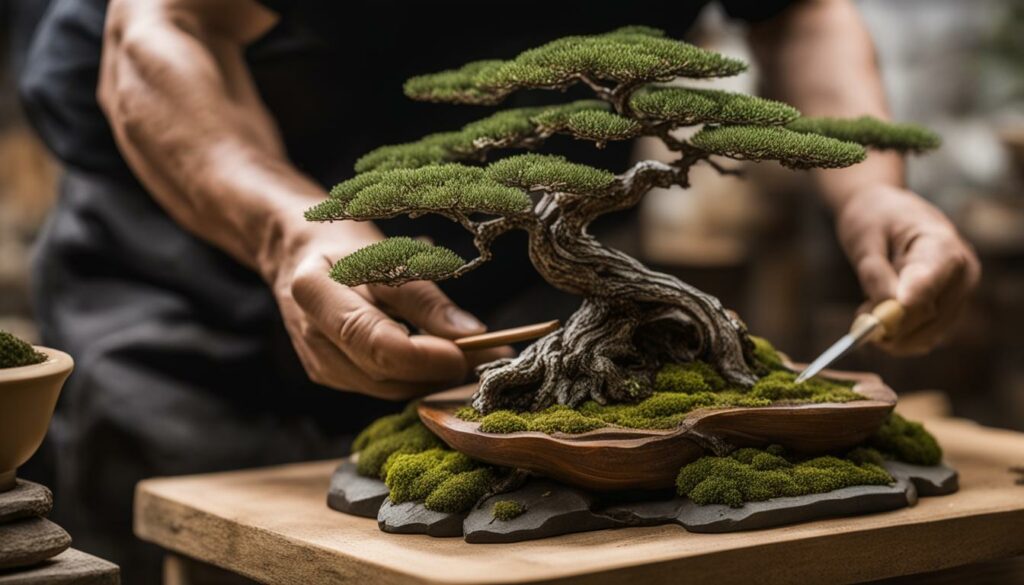
Uncovering the Beauty of Shari
Shari, the exposed and weathered trunk section of a bonsai tree, can add a striking visual element to your tree. As with Jin, creating Shari requires artistic deadwood techniques that complement the overall design and harmony of the tree.
The natural and realistic appearance of Shari can be achieved through wood manipulation techniques such as peeling, carving, and chiseling. By removing the bark and exposing the wood underneath, a beautiful and organic texture can be unveiled.
It is important to consider the placement and size of Shari in relation to the rest of the tree. Shari that is both too large and too small can detract from the overall aesthetic appeal of the tree. A well-placed and proportioned piece of Shari should highlight the natural beauty of the tree while also contributing to the overall balance and harmony.
By uncovering the beauty of Shari, bonsai enthusiasts can take their tree styling to new heights and create striking visual features that truly showcase the artistry of bonsai.
Tools and Materials for Jin and Shari Creation
Intricate deadwood techniques such as Jin and Shari require a specific set of tools and materials to achieve the desired effect. Before starting, it’s important to ensure you have everything you need for a successful project.
Tools:
The following tools are essential for wood manipulation techniques:
- Bonsai saw – used for cutting and shaping branches and trunks
- Concave cutters – for removing branches without leaving visible scars
- Wire cutters – used in wiring and shaping branches
- Power carving tools – rotary tools with different bits and attachments for carving and sculpting wood
- Screwdrivers – for tightening and loosening wires
Materials:
Materials needed for creating Jin and Shari are:
- Lime sulfur – used for bleaching deadwood features
- Wood preservatives – protect the wood and give it a natural look
- Waterproof glue – for attaching Jin or Shari to the trunk
- Brushes – for applying lime sulfur, stain, or preservatives
- Carving gouges – suitable for carving, chiseling, and texturing
Remember that each tool has its specific function, and it’s essential to select the right tool for the task at hand. Using improper tools may damage the tree or yield unsatisfactory results.
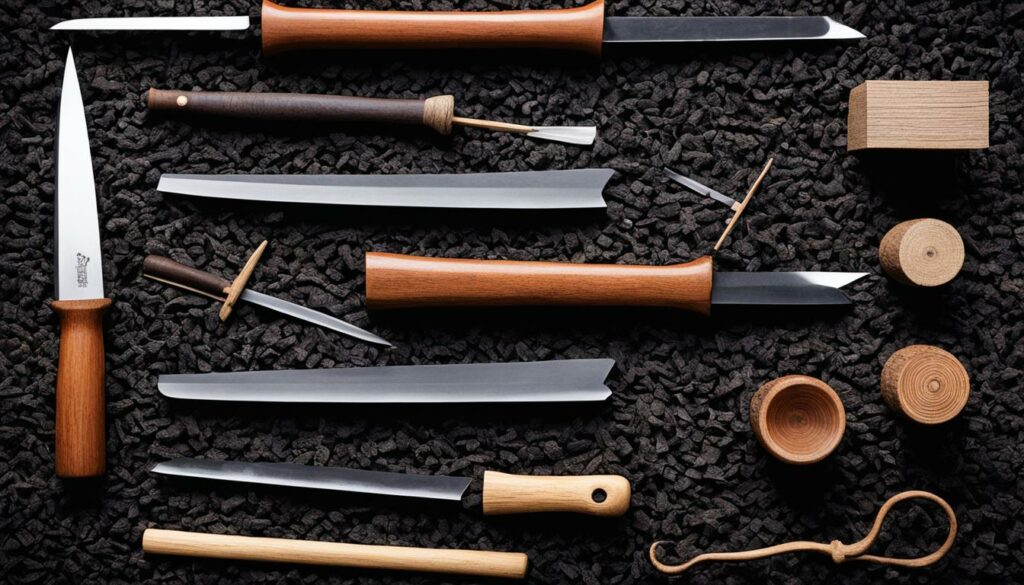
Incorporating Jin and Shari into your bonsai styling requires attention to detail and precision. With the right tools and materials, you can easily achieve elegant and realistic deadwood features in your bonsai trees.
Preparing the Tree for Jin and Shari Styling
Before you embark on the intricate deadwood techniques of creating Jin and Shari, it’s crucial to prepare your bonsai tree adequately. This will ensure the health of your tree and the longevity of your deadwood styling.
The first step is to groom the branches. Prune the excess foliage and cut away any crossing branches to enhance the tree’s long-term growth and structure. Next, remove any unwanted buds, giving the tree an even appearance and redistributing its energy.
Assess the tree’s overall health, ensuring it’s free from pests and diseases. A healthy bonsai is vital for creating beautiful deadwood features, so it’s important to address any issues before beginning the styling process.
In addition, consider the age and species of your bonsai tree. Certain species may not respond well to deadwood techniques, while others may need more time to heal from the manipulation. By considering these factors, you can better determine the appropriate approach to creating Jin and Shari, and avoid causing harm to your tree.
Techniques for Creating Jin
Creating Jin is a delicate process that involves various techniques. Each method creates a different effect on the tree and requires a particular set of tools. Here are some of the most common techniques to make artistic deadwood features:
- Carving: Carving involves using gouges, knives, and other cutting tools to shape the wood. It is one of the most effective ways to create Jin.
- Wiring: Wiring enables bonsai enthusiasts to manipulate the shape of the wood and create deadwood features by bending branches that would otherwise be too stiff to mold.
- Natural aging: This technique involves exposing the wood to the elements, such as sun and wind, until the deadwood develops naturally. This method is best suited for older trees.
It’s essential to understand the type of tree you’re working with to determine the best techniques to create Jin. Some species have more receptive wood that reacts well to certain methods, while other tree species require a different approach.
Regardless of the technique used, the ultimate goal is to achieve a realistic and aesthetically pleasing deadwood feature that complements the overall composition of your bonsai tree.
“Jin not only recreates trees’ natural decay, but it also expresses a sense of perseverance and strength in the life cycle. It’s a way of seeing beauty beyond the conventional standards of perfection, a practice of accepting and embracing the natural progression of life.”
Bonsai Tree Species Suitable for Jin Creation
| Species | Jin Qualities |
|---|---|
| Japanese Black Pine | This species is ideal for Jin, and it can be shaped with traditional carving methods. |
| Juniper | Juniper is known for its natural deadwood features, which can be enhanced through carving and wiring techniques. |
| Yaupon Holly | This species possesses fast-drying bark, making the carving method an effective technique for creating Jin. |
As you become familiar with different techniques and suitable tree species for Jin creation, you’ll develop a deeper appreciation for the artistry involved in bonsai styling with deadwood features.
Achieving Natural-Looking Shari
Shari is a vital element in bonsai styling, creating a sense of age, character, and natural beauty. To create the most realistic Shari, it’s essential to use proper wood manipulation techniques. Techniques such as hollowing, peeling, and chiseling are necessary to ensure that the deadwood features blend harmoniously with the rest of the tree.
Hollowing involves creating openings or cavities in the trunk that mimic natural wood decay. This technique creates depth and texture and adds a sense of realism to the overall design. Peeling involves removing the bark from the trunk, revealing the layer of sapwood or heartwood underneath. This technique can create interesting patterns and colors and adds subtle contrast to the tree’s design. Chiseling, on the other hand, is used to create rough, jagged edges that create the illusion of natural decay. This technique is great for creating Shari on larger trees or for enhancing the trunk’s ruggedness.
When creating Shari, it’s important to remember that less is sometimes more. Overdoing the Shari can overpower the tree and make it look unnatural. It’s also important to consider the tree’s overall design and harmony. Shari should complement the tree’s style and balance, rather than detract from it.
With proper wood manipulation techniques and an eye for detail, creating natural-looking Shari is achievable for any bonsai enthusiast.
Enhancing Jin and Shari through Texture and Color
Once you have created Jin and Shari in your bonsai, you can enhance their beauty by adding texture and color. By doing so, you can achieve a more lifelike and cohesive appearance for your tree. Here are some techniques to consider:
Moss Application
Applying moss to your bonsai creates a more natural and organic look, making it seem as if your tree has grown naturally in its surroundings. Moss can be used to cover Jin and Shari, and to provide a naturalistic effect around the tree’s base.
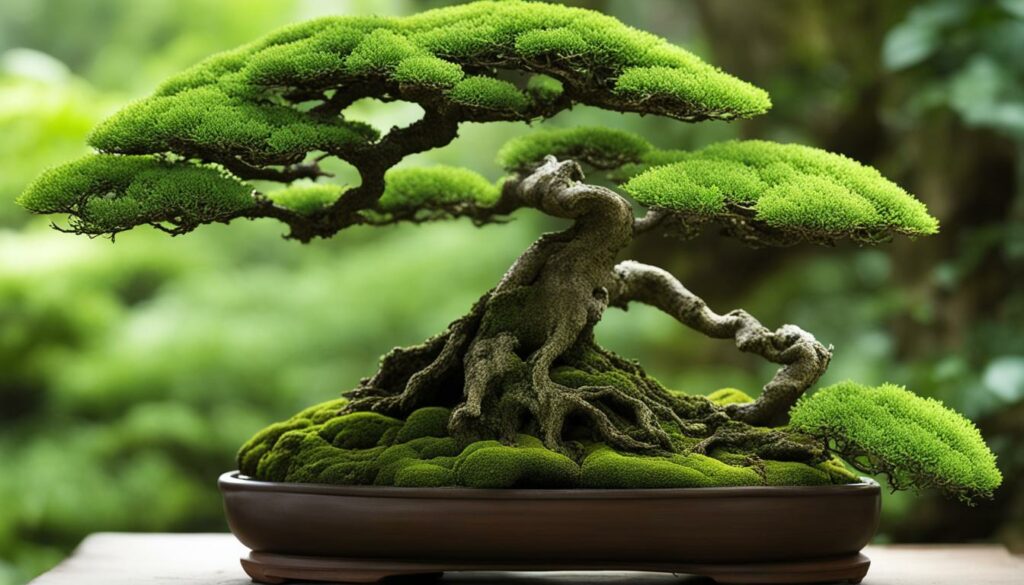
Wood Staining
Wood staining can be used to alter the color of Jin and Shari to create a more cohesive and harmonious look. This technique is particularly useful when working with deadwood that has different color tones, giving your bonsai a more cohesive appearance.
Tip: Always test a small area of the deadwood before applying stain to ensure the desired color is achieved.
Combining moss and wood staining can create a truly stunning effect that brings out the best of both techniques.
Remember that the goal of enhancing Jin and Shari is to create a natural look that blends with the rest of the tree. By selecting the right textures and colors, you will create a more lifelike, organic and harmonious composition.
Jin and Shari Maintenance
Regular maintenance is necessary to preserve the exquisite elegance of Jin and Shari. It’s crucial to examine the condition of the deadwood features periodically and address any issues promptly.
Cleaning and Preservation
When maintaining Jin and Shari, it’s essential to avoid the accumulation of dirt and dust. Use a soft-bristled brush or a clean, dry cloth to wipe the deadwood gently. In case of mold or fungus growth, clean the affected area with a mixture of bleach and water, followed by thorough rinsing. To preserve the deadwood’s natural appearance, apply a protective coating of boiled linseed oil or other wood preservatives that won’t harm the tree or its growth.
Trimming and Sculpting
As the bonsai tree grows, the Jin and Shari may require shaping and trimming for optimal proportions. Use sharp bonsai tools such as concave cutters, pruners, and carving knives to remove dead or damaged wood. When sculpting the deadwood into desired shapes or styles, use safe and controlled techniques such as wiring or carving. It’s crucial to be mindful of the tree’s health and aesthetic balance and avoid over-trimming or over-styling.
Protection from Sun and Environment
Direct sunlight and extreme weather conditions can damage the delicate deadwood features of Jin and Shari. To protect the tree and its deadwood elements, ensure that the bonsai is placed in an environment that offers balanced and appropriate light and temperature. Shield the tree from harsh winds, freezing temperatures, and excess rain. If necessary, use shading or protective materials to reduce the impact of sunlight on the deadwood.
“With consistent maintenance and care, the intricacy of Jin and Shari will remain a highlight in your bonsai’s overall beauty”
Styling Considerations and Inspirations
When crafting Jin and Shari in your bonsai, it’s important to consider how these intricate deadwood techniques will harmonize with other elements of your composition. You want to create a cohesive and aesthetically pleasing overall design.
Start by assessing your tree’s features and identifying its unique natural characteristics. Consider the tree’s trunk, branches, and foliage when determining the placement and style of your Jin and Shari.
Look to other bonsai artists for inspiration. Review bonsai galleries and exhibits to gain a better understanding of how different trees and styles work together. Take note of the techniques and styles used in these displays and incorporate them into your own work.
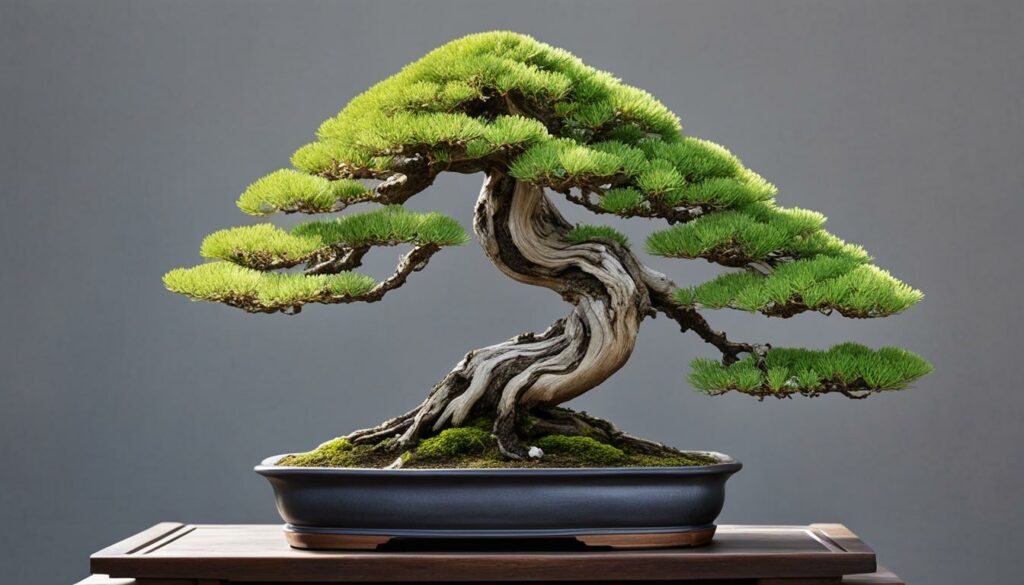
When working with Jin and Shari, you want to strike a balance between natural-looking deadwood and the living elements of your tree. Be sure to integrate Jin and Shari in a way that accentuates the beauty of your bonsai without detracting from its live elements.
By approaching Jin and Shari styling thoughtfully, you’ll be able to create a beautifully crafted bonsai that showcases the unique and elegant features of these intricate deadwood techniques.
Potential Challenges and Solutions
Creating Jin and Shari in bonsai requires a delicate understanding of artistic deadwood and wood manipulation techniques. As you embark on this process, you may face certain challenges that can impact the final outcome of your bonsai tree. To help you overcome these hurdles, here are some practical solutions:
Challenge: Rotten Wood
If you notice rotting wood in your bonsai tree, it can affect the creation of Jin and Shari. This problem can be addressed by removing the decaying section, and letting the unaffected wood dry out before continuing with the Jin or Shari styling.
Challenge: Over-carving
Over-enthusiastic carving can damage the overall structure of your bonsai or create unnatural-looking deadwood. To prevent this, start with small cuts and gradually work your way up to larger ones. Remember to take breaks and view your work from different angles to assess the balance and proportion of the tree.
Challenge: Inconsistent Deadwood Color
Creating Jin and Shari with a consistent deadwood color can be challenging. Uneven wood staining or moss application can spoil the overall effect of your bonsai tree. To ensure a uniform color, use a soft brush and dab the wood surface with moss or stain. Be sure to cover all areas evenly, and avoid excessive application.
By understanding potential challenges and solutions in the creation of Jin and Shari, you can achieve breathtaking results that complement the overall elegance and beauty of your bonsai tree.
Showcasing Jin and Shari: Bonsai Exhibitions and Displays
Participating in bonsai exhibitions and showcases is an excellent opportunity to display your Jin and Shari styling skills. When presenting your tree, it is vital to showcase the unique deadwood features that you created to captivate viewers.
To ensure your tree stands out, highlight the intricate details of the deadwood features, such as carving techniques and textures. Pairing Jin and Shari with other elements such as moss or rock formations can also enhance the tree’s overall appearance.
The presentation of your bonsai tree is just as crucial as the tree itself. Consider the placement of your tree in the exhibition space, ensuring it is visible and well-lit. Placing your bonsai tree at eye level allows viewers to appreciate the intricate details of the deadwood features.
Remember, bonsai exhibitions provide an opportunity to learn from experienced artists. Attend exhibitions, observe how the professionals present their Jin and Shari, and learn from their techniques.
Share your passion for Bonsai styling by displaying your Jin and Shari trees at local exhibitions, and invite feedback from experienced enthusiasts and fellow exhibitors.
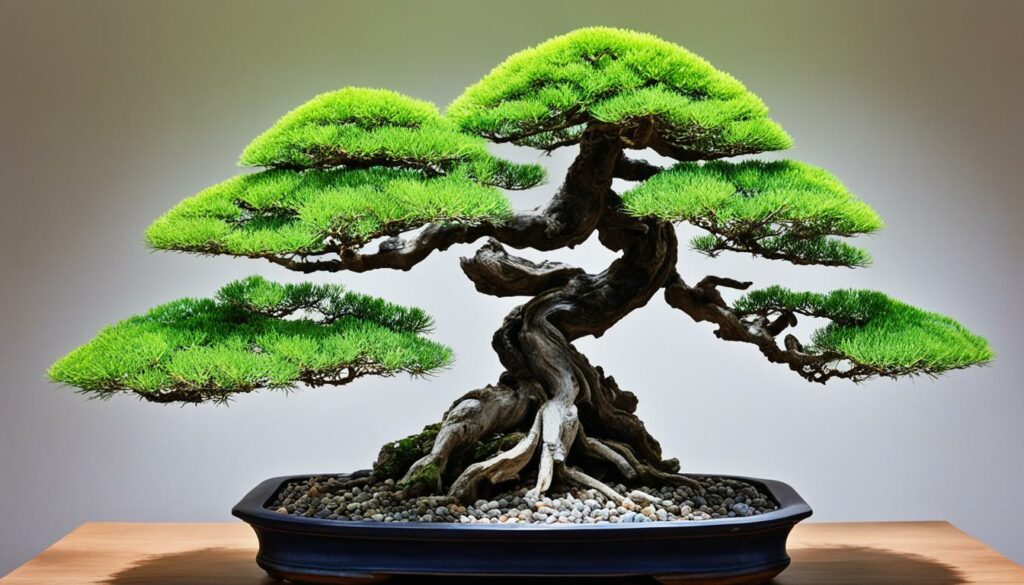
Bonsai Exhibitions in the United States
| Event Name | Location | Dates | Website |
|---|---|---|---|
| National Bonsai Exhibition | Rochester, New York | September 11-12, 2021 | https://nationalbonsai.org |
| Mid-Atlantic Bonsai Societies Spring Festival | Harrisburg, Pennsylvania | April 2-3, 2022 | https://absbonsai.org |
| American Bonsai Society Convention | TBD | October 1-3, 2021 | https://absbonsai.org |
Attending bonsai exhibitions and displays across the country can provide you with new insights and ideas for your Jin and Shari styling. Keep an eye out for events, shows, and conventions held in your local area, as they may present an excellent opportunity to showcase your artistic talents and view others’ artwork.
Cultivating an Artistic Eye for Jin and Shari
To create beautiful and realistic Jin and Shari in bonsai, cultivating an artistic eye is essential. Appreciating the natural characteristics of deadwood and understanding bonsai styling principles can help you develop a unique vision for your trees. There are many resources available to help you enhance your skills and deepen your knowledge of intricate deadwood techniques and bonsai features.
“Bonsai is a continuous learning process, and studying the techniques of deadwood styling allows you to master the art of creating deadwood features that can be used to express a tree’s age and natural condition,” says renowned bonsai artist Masahiko Kimura.
One of the best ways to improve your deadwood styling skills is through workshops and seminars. These events offer hands-on training and opportunities to work alongside experienced artists. Many bonsai organizations, such as the American Bonsai Society and the Bonsai Society of Greater New York, regularly host workshops and seminars.
You can also deepen your understanding of Jin and Shari by reading books and articles on the topic. Some recommended titles include “The Art of Bonsai: Creation, Care and Enjoyment” by Yuji Yoshimura and Giovanna M. Halford, and “Jin and Shari: How to Create Stunning Bonsai Deadwood” by Peter Chan.
Finally, attending bonsai exhibitions and shows can also help you refine your artistic eye. These events offer the chance to see how expert bonsai artists use intricate deadwood techniques to create stunning compositions. Observing how deadwood elements contribute to the overall design and harmony of a tree can help you develop your own artistic vision.
With dedicated practice and exposure to various learning opportunities and resources, you can master the art of Jin and Shari in bonsai, and create stunning works of art that showcase the beauty of intricate deadwood techniques and bonsai features.
Conclusion
Congratulations on completing this guide to Jin and Shari in bonsai. You now have a deeper understanding of these intricate deadwood techniques and their role in enhancing the beauty and elegance of your bonsai trees.
Remember to approach Jin and Shari styling with care, taking into consideration the overall design and harmony of your tree. With the right tools, materials, and techniques, you can achieve stunning deadwood features that can captivate viewers in bonsai exhibitions and displays.
Regular maintenance is also crucial in preserving the beauty of Jin and Shari, ensuring long-lasting elegance in your tree. With practice and patience, you can cultivate an artistic eye for these elements of bonsai styling, appreciating their natural beauty and incorporating them into your own unique compositions.
Thank you for reading, and we hope this guide has been informative and helpful in your bonsai journey.
FAQ
What are Jin and Shari?
Jin and Shari are artistic elements in bonsai that involve wood manipulation techniques to create deadwood features on the tree. Jin refers to the stripped and weathered branches, while Shari refers to the exposed and weathered trunk section.
What is the significance of Jin in bonsai styling?
Jin represents natural tree decay in bonsai styling. It adds character and age to the tree, enhancing its overall aesthetics. Various techniques such as carving, wiring, and natural aging can be used to create Jin.
How can I create natural-looking Shari in bonsai?
To create natural-looking Shari, you can use techniques such as hollowing, peeling, and chiseling. These techniques help mimic the natural weathering and decay of the trunk, resulting in a realistic and harmonious trunk detail.
What tools and materials are needed for creating Jin and Shari?
Essential tools for creating Jin and Shari include carving knives, wire cutters, branch benders, and a bonsai pruning saw. Materials such as lime sulfur, pruning sealant, and wood stains may also be used depending on the desired effect.
How do I prepare my bonsai tree for Jin and Shari styling?
Before starting Jin and Shari styling, you should groom the branches by removing unnecessary growth and pruning them to create a desired design. It’s also important to assess the tree’s overall health and ensure it is strong enough to withstand the manipulation process.
How can I enhance Jin and Shari through texture and color?
To enhance the beauty of Jin and Shari, you can apply techniques such as moss application and wood staining. Moss adds texture and a natural element to the deadwood, while wood staining helps achieve a lifelike and cohesive appearance.
How do I maintain Jin and Shari in my bonsai tree?
Regular maintenance is important to preserve and care for Jin and Shari. This includes periodic cleaning to remove dust and debris, as well as applying lime sulfur to prevent rot and maintain the color and texture of the deadwood.
What are some common challenges in creating Jin and Shari?
Common challenges in creating Jin and Shari include achieving natural-looking results, preventing rot and decay, and maintaining the overall health of the tree. Proper techniques, tools, and maintenance practices can help overcome these challenges.
How can I incorporate Jin and Shari harmoniously in my bonsai composition?
When incorporating Jin and Shari, consider the overall design and aesthetics of your bonsai composition. Harmonize the deadwood features with other elements such as foliage, branches, and pot selection to create a cohesive and visually pleasing arrangement.
How can Jin and Shari be showcased in bonsai exhibitions and displays?
Jin and Shari play a significant role in bonsai exhibitions and displays. To showcase these unique deadwood features, position the tree in a way that highlights the Jin and Shari, and use appropriate lighting and photography techniques to captivate viewers.
Are there resources available to improve my skills in creating Jin and Shari?
Yes, there are various resources such as bonsai books, online tutorials, workshops, and bonsai clubs that can help you improve your skills in creating Jin and Shari. These resources provide valuable guidance and inspiration for mastering this captivating art form.
